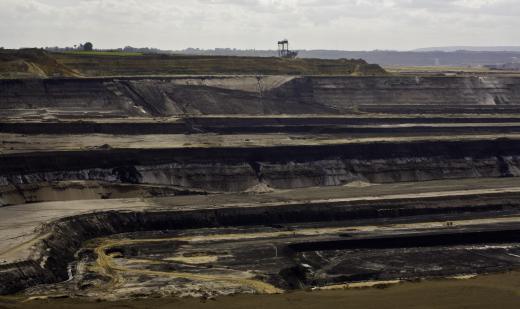A box cut serves as the first step in the excavation of most mining areas. It consists of a single rectangular cut made in the surface of the earth, forming a box shape. Box cut mining is primarily used for extracting coal, but may also be applied to other types of materials ranging from metals to minerals. Depending on where these materials lay in relation to the surface of the earth, a box cut may be the sole excavation method used on a project, or may be the first of many methods employed.
In basic strip or surface mining, workers start by using a dragline excavator to create a box cut along the length of the site. The earth and rocks removed from this cut are set aside above ground for later reuse. Workers then enter the trench created by the box cut and mine all available minerals and ore. Once the trench has been stripped, the soil and rocks are used to refill the box cut. Workers may continue this process across the land, cutting and filling one strip at a time before moving on to the next.

The box cut may also be employed for mining coal that is located at a steep slope to the surface of the earth. During this process, workers start by creating a box cut deep enough to reach the start of the coal deposit. This box cut serves as an access point for deeper mining. For example, a shaft may be drilled from inside the trench to the base of the coal deposit. Working out of this type of trench puts workers closer to the materials they are mining, and often results in increased soil stability and safety compared to working from the earth's surface.
In order to support the trenches created by these cuts, workers rely on a variety of shoring techniques. Rock bolts are used to pin the walls of the trench into the surrounding rock or soil, which helps to prevent cave-ins. Wire mesh may be used to cover these walls to reduce the risk of rock or dirt sliding onto workers below. On long-term mining projects, the walls of the trench may be covered with shotcrete to provide maximum strength and stability. On very deep box cuts, the walls of the trench must be sloped out to further mitigate risk.
Compared to other mining techniques, box cutting is relatively fast and easy. Unlike more complex methods, it requires only a large excavator and basic shoring supplies. It also serves as an effective method of subsoil exploration prior to investing in other equipment.
Despite its many benefits, box cut mining is also associated with a number of potential risks or limitations. Even on very shallow trenches, a cave-in could easily kill workers. Shoring and support must be employed to reduce this risk. Ventilation is also a major concern, particularly as these trenches grow deeper and deeper.
